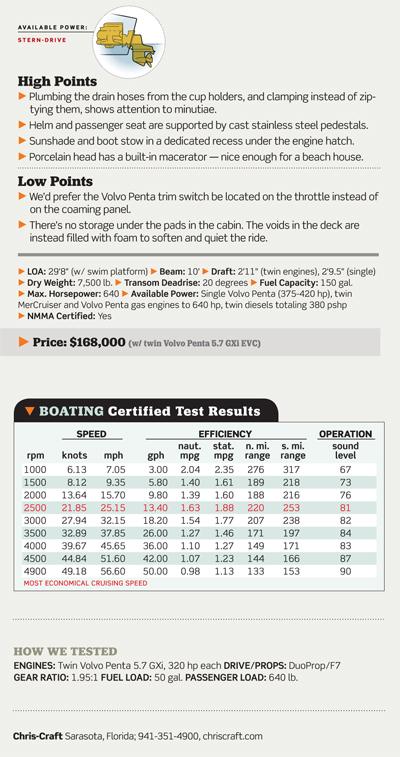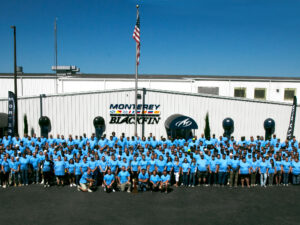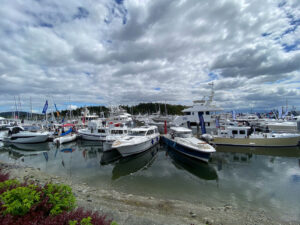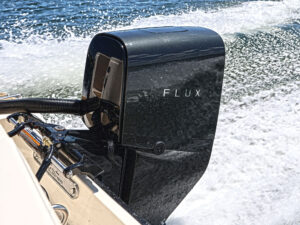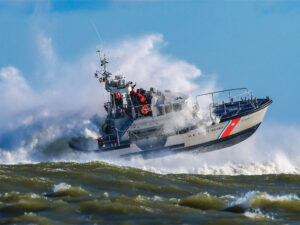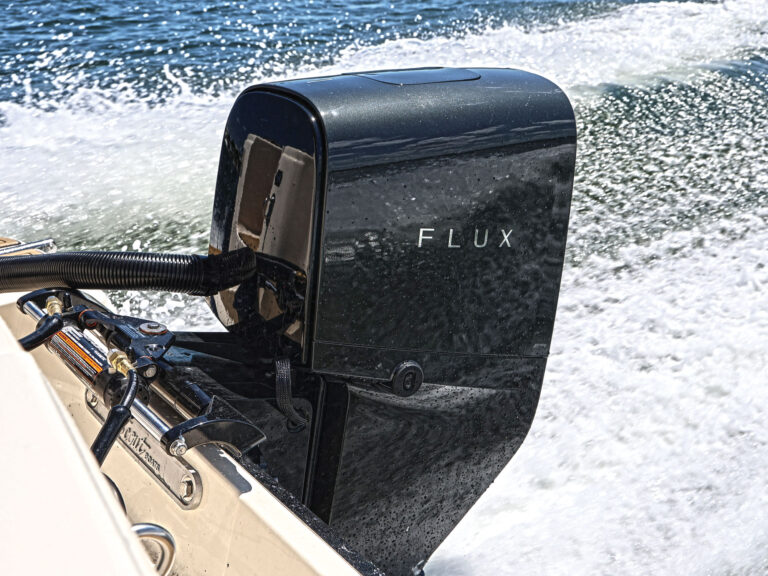For a gallery of the Corsair 28 in action click here.
The wakes from an oncoming trawler were rolling toward us, giving me about 2.5 seconds to make a decision. The maneuver on a center console would be to meet the wake, quarter it and charge on. But in the Rolls-Royce of runabouts, there’s a temptation, given enough water, to change course enough to avoid the wake — you wouldn’t hum over speed bumps in that Rolls, right? For this exercise, though, I treated the Corsair 28 as you would a burgee-less, workmanlike cuddy. The head-on wakes came…and went, with just a tappety tap on the hull. So, I spun around and did it again from a following sea. This is not how you’re supposed to treat a Chris-Craft, is it?
We typically spend so much time ogling the art of a model like the Corsair 28 that we nearly lose sight of how and why it’s built — namely, to go boating. During our test, punctuated with atypical maneuvers like hardover turns and wake plowing, none of the four passengers reached for the safety rails, which themselves are yachtishly elliptical. The maneuvers at the helm didn’t even disturb the conversation in the cockpit. The mass of the cabin’s foredeck helps a bit with weight distribution, and insulation blown into the hull and deck is credited for quieting the ride. But contrary to many perceptions, Chris-Craft builds its Corsairs to muscle up. It isn’t about being the lightest or quickest 28-footer, though 56 mph was a nice clip in our test. The idea is to use copious amounts of top-end material to give the boat a heavy and firm feel. This makes it comfortable and elegant, and not just in calm harbors.
Still, after busting up the bay, I felt like asking for a white fleece towel to spiff up the gel and teak. To own this boat you have to enjoy wiping and buffing, the same type of finicky attitude used in the construction process. I could tell with one look at the screws on the hinges — all turned, or “clocked,” to line up with each other. A close inspection uncovered additional meticulousness on a rare level:
• The clips that hold the coaming pads in place, though never seen, are stainless steel, so there will be no bleeding of rust underneath the pads.
• The fabric specialists use a different color thread in the upholstery — double french-stitched, to give it an additional accent.
• There are zero plastic parts, and the only StarBoard material is on the backs of the seats. You can’t see it because it’s upholstered and embroidered.
• Nylon spacers are used to keep the screws from scratching the perforated aluminum accent plate on the dash.
• Self-supporting hinges are used on the cabin door, instead of gas-assist shocks, because the hinges are less obtrusive.
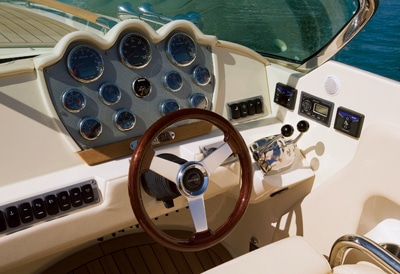
We could easily fill the rest of these pages with bullet points of fine details, but let’s just mention one more that embodies the Corsair: the frame around the doublewide helm seat. Made of stainless steel tubing 1.75 inches in diameter, it’s shaped from the back of the driver’s neck to the knees, all in one beefy piece.
By using premium parts, fewer are needed, which should mean fewer potential issues. If you want flip-up bolsters and flip-down loungers, look elsewhere, but think about how those moving parts will hold up over time, especially in a salty environment.
We never tasted salt in our test, even when piercing wakes. Chris-Craft’s trademark bow flare was originally designed decades ago to knock down spray. It still does, but on the Corsair 28 it also transitions into wide gunwale tops extending from the windshield back to the swim platform. They make for a unique style line, accentuated by the shaped teak inlays, and the width of them is functional when tending lines and unloading gear at the slip.
The entire deck is six inches wider than that found on the previous generation of the Corsair 28. This was done by reworking height of the deck’s base and pushing the gunwales out. Instead of filling the additional space with “stuff” (i.e., more parts), the engineers kept the cockpit open. For example, the U-shaped lounge has straight corners (forming a square U) instead of rounded edges that would cut side-to-side inches from the aft end of the cockpit. Again, the quality of the materials, and not the number of accessories, is what makes the boat elegant, much like Hinckley’s 29-foot Talaria (similar to the Corsair with its flared bow, classic design and premium build, though the custom Talaria uses diesel jet propulsion and reaches a top speed of 33 knots…and sells for well above $300,000).
We doubt the typical buyer will weekend on the Corsair. It’s the highest-end cuddy but still has no galley or stand-up head, so the cabin will most likely be used to nap, occasionally overnight, or to duck out of inclimate weather. You don’t necessarily have to pamper the boat, but it will pamper you.
Comparable model: Hinckley Talaria
